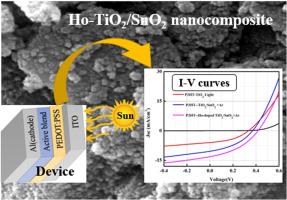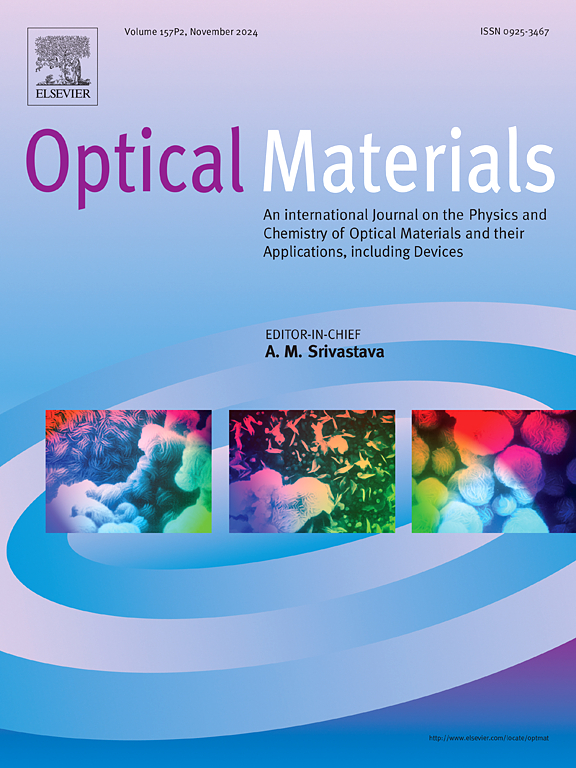通过与 P3HT 混合的有机染料敏化掺钬 TiO2/SnO2 纳米复合材料提高染料敏化太阳能电池的效率
IF 3.8
3区 材料科学
Q2 MATERIALS SCIENCE, MULTIDISCIPLINARY
引用次数: 0
摘要
对可持续能源解决方案的追求推动了光伏技术的创新,其中染料敏化太阳能电池(DSSC)成为前景广阔的竞争者。本研究提出了一种利用掺钬 TiO2/SnO2 纳米复合材料与有机染料(砒霜-III、胭脂虫酸和双硫仑)和聚(3-己基噻吩)(P3HT)混合敏化的新方法。通过细致的表征和分析,对包括短路电流密度 (Jsc)、开路电压 (Voc)、填充因子 (FF) 和总效率 (%) 在内的关键参数进行了仔细研究,以全面评估光伏性能。吸收光谱分析有助于计算带隙,发现在掺入钬并与二氧化锡耦合后,带隙从纯二氧化钛(TiO2)纳米粒子的 3.10 eV 显著降至 2.72 eV。值得注意的是,掺杂钬的砒霜-III 染料敏化 TiO2/SnO2 纳米复合材料表现出最高的功率转换效率,达到 2.10 %,比参考装置(0.82 %)有显著提高。这种改进归功于掺杂钬和二氧化锡相互作用的协同效应,从而提高了光响应速度。这些发现不仅验证了纳米杂化组件的功效,还为太阳能电池技术的发展提供了宝贵的见解。本文章由计算机程序翻译,如有差异,请以英文原文为准。

Enhancing dye-sensitized solar cells efficiency through organic dyes-sensitized holmium-doped TiO2/SnO2 nanocomposites blended with P3HT
The pursuit of sustainable energy solutions has spurred innovation in photovoltaic technology, with dye-sensitized solar cells (DSSCs) emerging as promising contenders. This study presents a novel approach leveraging holmium-doped TiO2/SnO2 nanocomposites sensitized with organic dyes, Arsenazo-III, carminic acid, and dithizone, blended with poly (3-hexylthiophene) (P3HT). Through meticulous characterization and analysis, key parameters including short-circuit current density (Jsc), open-circuit voltage (Voc), fill factor (FF), and overall percent efficiency (%) were scrutinized to evaluate photovoltaic performance comprehensively. Absorption spectra analysis facilitated the calculation of band gaps, revealing a significant reduction from 3.10 eV in pure Titania (TiO2) nanoparticles to 2.72 eV upon doping with Holmium and coupling with SnO2. Notably, Arsenazo-III dye-sensitized holmium-doped TiO2/SnO2 nanocomposites exhibited highest power conversion efficiency, achieving a promising efficiency of 2.10 %, which marked a significant improvement over the reference device (0.82 %). This improvement is attributed to the synergistic effects of holmium dopant incorporation and SnO2 interaction, enhancing light responsiveness. The findings not only validate the efficacy of nanohybrid assemblies but also contribute valuable insights to solar cell technology advancement.
求助全文
通过发布文献求助,成功后即可免费获取论文全文。
去求助
来源期刊

Optical Materials
工程技术-材料科学:综合
CiteScore
6.60
自引率
12.80%
发文量
1265
审稿时长
38 days
期刊介绍:
Optical Materials has an open access mirror journal Optical Materials: X, sharing the same aims and scope, editorial team, submission system and rigorous peer review.
The purpose of Optical Materials is to provide a means of communication and technology transfer between researchers who are interested in materials for potential device applications. The journal publishes original papers and review articles on the design, synthesis, characterisation and applications of optical materials.
OPTICAL MATERIALS focuses on:
• Optical Properties of Material Systems;
• The Materials Aspects of Optical Phenomena;
• The Materials Aspects of Devices and Applications.
Authors can submit separate research elements describing their data to Data in Brief and methods to Methods X.
 求助内容:
求助内容: 应助结果提醒方式:
应助结果提醒方式:


